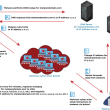Cyberattacks soared in 2023, impacting 343M+ people. Data breaches rose 72% from 2021-2023. Proof of Concept (PoC) helps organizations test and select the best cybersecurity solutions.
According to Forbes, cyberattacks increased in 2023, affecting more than 343 million people. Between 2021 and 2023, data breaches rose by 72%, surpassing all previous records. In today’s digital era, as cyber threats become increasingly sophisticated, securing infrastructures becomes a real priority for organizations.
Large enterprises and governmental agencies have higher stakes due to the scale of their operations and the sensitivity of their data. Whether building a new infrastructure from scratch or upgrading outdated systems, choosing the right cybersecurity solution is a critical decision that can have lasting impacts on an organization’s security posture.
One effective way to make an informed choice is by conducting a Proof of Concept (PoC) with potential vendors. This article delves into what a POC entails in the context of cybersecurity, who benefits from it, and why it’s essential.
What is a PoC?
A Proof of Concept is a demonstration project designed to determine whether a particular idea, strategy, or plan is feasible and has the potential for success. PoCs are essential: they focus on testing viability rather than producing final deliverables, helping validate concepts before committing significant resources.
In cybersecurity, PoCs test products in realistic conditions to verify their effectiveness in protecting infrastructure.
But a PoC is more than just a feasibility test. PoCs foster collaboration by gathering feedback from diverse team members, identifying potential issues early, and ensuring solutions align with specific organizational needs and expectations.
Who Needs a PoC and Why
Generally, organizations that need to protect their infrastructure – for example, several thousand workstations – already have solutions in place to protect against hacker attacks and viruses. However, there are two situations where new cybersecurity solutions are required:
1: Greenfield Projects
In a Greenfield scenario, a company builds its infrastructure from scratch because it didn’t exist before. For example, a new bank or a company expanding into a new region and since there are no legacy systems in place, the organization needs to select and implement cybersecurity solutions that can effectively safeguard their operations from the outset.
2: Requirements change
A PoC becomes crucial when an organization’s cybersecurity solution is outdated or non-compliant with new regulations, such as changes in regulatory requirements or discontinued vendor support.
In both cases, organizations conduct a PoC to:
- Validate Compatibility: Ensure the new solution integrates seamlessly with their specific infrastructure.
- Assess Effectiveness: Test the product’s ability to protect against cyber threats through simulated attacks.
- Meet Regulatory Requirements: Confirm that the solution complies with any relevant regulations, such as the necessity for on-premises deployment.
- Make Informed Decisions: Evaluate potential vendors based on real-world performance rather than just proposals or presentations.
The Stages of a PoC and How It Proceeds
Conducting a Proof of Concept involves several stages that help an organization evaluate a cybersecurity solution’s effectiveness before full-scale implementation. Based on the information provided, the stages are as follows:
1. Define the Objectives and Scope of the PoC
Start by forming requirements. The IT department should create a document detailing the objectives and criteria for the PoC, ensuring it aligns with organizational needs. Objectives might include assessing the effectiveness of a cybersecurity solution in protecting infrastructure.
2. Set PoC‘s success criteria
After forming your requirements, it’s crucial to establish clear criteria for evaluating the success of the PoC. This involves:
- Developing a Test Plan: Create a detailed test plan that outlines the attack scenarios to be simulated, the product requirements, and the specifics of your infrastructure. This document serves as a blueprint for the PoC and ensures that both your organization and the vendor are aligned on the objectives.
- Defining Expected Outcomes: Specify what constitutes a successful response to each simulated attack. This could include how the system prevents data leaks, detects threats, and maintains operational stability during testing.
Establishing success criteria in advance provides an objective basis for evaluating the vendor’s solution, ensuring the assessment aligns with your organization’s needs and supports informed decision-making.
3. Estimate its duration and assess required resources
Before proceeding with the POC, it is important to estimate its duration and assess the resources required. According to the information provided:
Duration:
- Preparation of the Test Plan: This stage takes several days.
- Testing Phase: Depending on the complexity of the infrastructure and the number of test scenarios, testing can last from a couple of days to a week.
- Analysis and Reporting: An additional few days are needed to analyze the results and compile the report.
- Total Time Frame: On average, the entire PoC process takes from one to three weeks.
Required Resources:
- Personnel: Engineers are needed to prepare the test plan, conduct the testing, and write the report. Typically, a team of 2–3 specialists is involved.
- Access to Infrastructure: If the infrastructure is standard, testing can be conducted at the vendor’s office or a partner’s laboratory. If specific or specialized equipment is involved, such as industrial automation systems, testing is performed on the customer’s site.
- Remote Testing Possibility: In most cases, demonstrations are conducted remotely if the customer provides access to their infrastructure. This reduces logistical complexities and speeds up the process.
- Vendor Participation: The vendor acts as a “white hacker,” emulating attack scenarios to demonstrate how their solution protects the infrastructure.
Cost Considerations:
- Typically Free of Charge: Conducting a POC is often offered free of charge by vendors. They are interested in selling their solutions, and the POC provides an opportunity to showcase the product in action.
- Vendor’s Investment: The main expenses for the vendor are related to the work of their engineers who prepare the test plan, execute the testing, and compile the report.
Understanding these factors contributes to a smoother POC process, allowing for a thorough evaluation of the cybersecurity solution within a realistic and manageable timeframe.
4. Execute the POC according to the plan and assess its success against previously prepared criteria.
With the test plan and necessary templates in place, proceed to execute the Proof of Concept (POC) according to the outlined plan. This involves:
- Simulating Attacks: The vendor acts as a “white hacker,” emulating the attack scenarios specified in the test plan to demonstrate how their solution protects your infrastructure. This includes creating various attack scenarios, recording logs, and showing how the system prevents data leaks or operational disruptions. Testing can be conducted live or analyzed post-factum with subsequent examination of logs.
- Recording Results: Throughout the testing process, logs are meticulously recorded to capture the system’s responses to each simulated attack. This data is crucial for later analysis and helps in assessing the effectiveness of the solution against the predefined success criteria.
After the execution of the POC:
- Analyzing Results and Reporting: The vendor prepares a comprehensive report that documents the outcomes of the testing. This report includes:
- Evaluation of Each Scenario: Details on how the system performed in response to each attack scenario, supported by logs and technical data.Assessment of Success Criteria: An analysis of whether the solution met the previously established success criteria for each test case.
- Observations and Recommendations: Notes on any areas where the solution did not meet expectations and suggestions for potential improvements or adjustments.
- Assessing Success Against Criteria: Review the report to assess how well the product meets your specific requirements. Compare the actual performance with the success criteria established earlier to determine the solution’s suitability.
- Decision-Making:
- If the Solution Meets Requirements: If the product performs well, you may proceed to contract negotiations and plan for implementation.
- If Issues Are Identified: If issues arise, document them in the report. The vendor may propose improvements, but significant shortcomings affecting key functionalities could lead to their exclusion from consideration.
The Most Popular Test Cases
During a Proof of Concept (POC), organizations focus on testing cybersecurity solutions against common attack scenarios to evaluate their effectiveness. The most popular test cases include:
- Phishing Attacks: Assessing how the system responds to attempts to obtain confidential information through fake emails or websites.
- Exploitation of Vulnerabilities: Simulating attacks that use known vulnerabilities in software or network equipment.
- DDoS Attacks: Evaluating the infrastructure’s resilience to Distributed Denial of Service attacks.
- Insider Threats: Simulating actions of insiders attempting to gain unauthorized access to data or systems.
- Targeted Attacks on Infrastructure: Modeling complex, multi-stage attacks on critical systems.
These test cases are commonly used because they represent significant threats that organizations frequently encounter. By emulating these scenarios during the POC, organizations can observe how effectively the cybersecurity solution detects, prevents, and responds to various types of attacks that are most relevant to their operational environment.
Conclusion
A Proof of Concept is crucial because it allows organizations to thoroughly evaluate a cybersecurity solution before making a significant investment. By testing the product in real-world conditions, a POC helps identify any shortcomings or compatibility issues, mitigating risks.
It enables organizations to make informed decisions based on actual performance rather than just proposals or presentations. Conducting a POC can save money by avoiding investments in solutions that may not meet the organization’s requirements. Ultimately, it ensures that the selected cybersecurity solution is effective, compatible, and tailored to the organization’s specific needs.
RELATED TOPICS
- Vulnerability Risk Management for External Assets
- Professions That Are the Most Exposed to Cybersecurity Threats
- Why Incident Response Planning is Critical for Cybersecurity Resilience
- Automating Data Encryption & Security Audits for Continuous Protection
- Firmware Security: Finding Risks, Implementing Cybersecurity Practices









